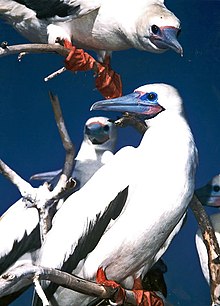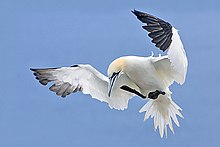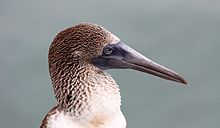Boobies
| Sulidae | ||||||||
|---|---|---|---|---|---|---|---|---|

White-bellied Booby ( Sula leucogaster ) |
||||||||
| Systematics | ||||||||
|
||||||||
| Scientific name | ||||||||
| Sulidae | ||||||||
| Reichenbach , 1849 |
The gannets (Sulidae) are a family of sea birds from the order Suliformes . They are named after their awkward-looking walk on the mainland; however, they are excellent glider pilots and spend most of their life in the open ocean. Boobies are represented as breeding birds from the Arctic through the tropics to the sub-Antarctic.
features
Boobies are medium to large birds. The smallest species, the brown gannet, has a body length of 64 centimeters and a weight of 724 grams; the largest species, the northern gannet, has a body length of 100 centimeters and weighs up to 3.6 kilograms. They have a torpedo-shaped body, short neck, wedge-shaped tail, and narrow angled wings.
Black, brown and white plumage colors predominate, and the yellow head and neck area is typical of the species of the genus Morus . In the face and throat area there are feathered areas that can be brightly colored and take on bright colors, especially during the courtship season. Regarding the plumage color, there is no sexual dimorphism , but in other characteristics: The beak color of males and females is different in some species, as is the eye color; in addition, females are on average larger than males. The youth plumage is usually darker than the plumage of adult birds. The exception here is the gray-footed booby , in which adult and juvenile birds look largely the same.
The beak is long, strong and conical in shape. It has sharp cutting edges that can hold slippery prey such as fish securely. Only the gray-footed booby has a hook at the end of its beak. The eyes are directed forward, so boobies have a very good spatial perception. The actual nostrils are closed, but boobies have secondary nostrils that can be closed by movable flaps when diving.
The long and narrow wings start relatively far back on the body and enable skilful gliding in strong winds. The larger species in particular need a run-up to take off, regardless of whether they take off from the water or on land. When there is no wind, it may be impossible to take off. Landing on land looks cumbersome and can end in falls, as the narrow wings do not allow agile maneuvers. The legs are set far back on the body and allow only a waddling gait, but are helpful for swimming and diving. The four toes are like all species of the order Suliformes entirely with webbed connected.
voice
The boobies that breed in colonies are not only able to recognize their partners and their young by their voice, but also to identify the birds that breed in the immediate vicinity. The calls of the boobies range from utterances, which in the gray-footed booby are reminiscent of the calls of a cattle, to the thin whistling of the blue-footed booby. In some species there are marked differences between the calls of the two sexes. Blue-footed, brown and masked boobies show significant differences in the structure of the larynx depending on their sex . With them the males whistle, while the females tend to make grunts. In the Cape Booby and the Australian Booby, the male voice is perceptibly higher than that of the female. In the case of the northern gannet, on the other hand, there is no gender-dependent difference in the calls.
distribution and habitat
Most species live in tropical and subtropical climatic zones, which are inhabited by the genera Sula and Papasula - only the guano booby reaches the temperate zone in Patagonia . The yellow-headed boobies of the genus Morus breed in temperate and subpolar latitudes, but can also be found in tropical and subtropical zones outside the breeding season.
Boobies are pronounced deep-sea birds that usually only come ashore to breed. Shallow beaches of oceanic islands, steep cliffs or trees can be considered as breeding grounds. Blue-footed and masked boobies belong to the ground breeders; the northern gannet is a typical cliff tank (although some of its colonies are also located on shallow stretches of beach); Red-footed and gray-footed boobies, on the other hand, are tree breeders.
The only European species is the northern gannet, which has also been breeding on the island of Helgoland since the 1990s . The colony there has grown steadily and now comprises more than 200 breeding pairs. The largest colony in the world is on Eldey off the coast of Reykjanes in southern Iceland. The last count showed 70,000 breeding specimens.
Way of life
nutrition
Tölpel are shock divers who dive into it from quite a great height (10 to 30, sometimes even 100 m) down discharged in a dive, and so in fish. The birds can reach a depth of ten meters simply by the momentum of the swoop; deeper depths (up to 25 m) are reached by flapping their wings under water. Mainly mackerel , sardines , anchovies and sand eels are captured in this way . Each species prefers certain types of fish, but none is defined in such a way that it cannot easily switch to other fish in times of shortage. The fish are mostly swallowed underwater and only rarely brought to the surface.
Most species of species catch their prey by shock diving, but other hunting methods exist as well. In the tropics in particular, flying fish and flying squids can be captured without touching the surface of the water. This form of hunting is mainly practiced by the red-footed booby. The blue-footed booby, on the other hand, dives into the water from a swimming position after its food fish. Some boobies also follow fishing trawlers and eat the fish waste thrown overboard.
Boobies often hunt together for their prey. This is particularly characteristic of the guano and northern gannet. Hunting parties can number several hundred birds diving for fish almost simultaneously.
Reproduction
With the exception of the gray-footed booby, all booby species breed in large colonies. These could once include up to 750,000 pairs in the guano booby; Northern gannets, Cape gannets and red-footed boobies were also able to form colonies of over 100,000 pairs. It is usually incubated once a year, although the tropical species do not necessarily breed at fixed times in the year and the breeding interval can therefore be between ten and fifteen months; the gray-footed booby only breeds every two years. The boobies of the genus Morus live in lifelong monogamy , while the boobies of the genus Sula can have different partners every year. In colonies, boobies show a number of ritualized behaviors that serve to bond with couples, avoid aggression or other purposes. Often there is a fixed greeting ritual as soon as a partner returns to the nest, and other ritualized gestures, for example when a partner leaves the nest.
In the case of the ground-dwelling species, the nest consists only of a recess that is covered with little or no material. Sometimes it is surrounded by a wall of excrement (guano). The tree-breeding species build an unstable nest of twigs that is held together by excrement; these nests are often destroyed in storms.
In most species, the clutch consists of only one egg. Exceptions are blue-footed, masked and brown boobies with two eggs each and the guanot booby with an average of three eggs per clutch. Depending on the species, the eggs measure between about 53 by 36 and 82 by 49 millimeters; this corresponds to 3 to 7.5 percent of the body weight of the female, which is a relatively small figure. The eggs are incubated with the feet, that is, the bird stands with all its weight on the egg; in order to withstand this load, the shells are extremely thick. The breeding period is 41 to 45 days, for the gray-footed booby up to 57 days.
The young are never left unguarded during the first month of life. Even after that, they will still be looked after and fed themselves if they can already fly independently. Even in the boobies with more than one young per clutch, only one young is usually fledged. In the masked booby and the brown booby, the stronger boy always kills the weaker one ( cainism ). On the other hand, with the guano booby it happens quite often that two or even three young are raised and can fly out.
Life expectancy
On average, 50 to 70 percent of the hatched chicks fledge. Above all, food shortages contribute to the fact that young birds do not fledge. The risk of not being able to get enough food for the young birds varies depending on the species. In the gray-footed booby, eight out of ten hatched chicks starve to death in some years. Bryan Nelson estimates that a gray-footed booby, which lives through the typical life span of 25 years for this species, only raises three young birds to be able to fly. The blue-footed booby, on the other hand, raises an average of 8.4 young birds capable of flying, and the northern gannet, which is 20 years old, has an average of 14 offspring that reach the stage where they are independent of their parent birds.
Tribal history
The oldest fossil boobies come from the early Oligocene . They belonged to the species Sula ronzoni . In the Miocene and Pliocene , the family was represented far more species-rich than today and also populated the North Pacific, where boobies are now absent.
Most of the fossil boobies are also assigned to the recent genera Sula and Morus . In addition, the following genera, which are now extinct, have been described:
- Empherosula , genus name proposed by Harrison for Sula arvernensis from the Oligocene
- Microsula , two small species of booby species from Miocene Europe and North America
- Miosula and Palaeosula from the Miocene and Pliocene of California
- Sarmatosula from the Miocene of Romania
Boobies evidently developed in the northern hemisphere. In the southern hemisphere, fossil boobies have only been found since the Pliocene, i.e. relatively late. They only disappeared from the northern Pacific in the Pleistocene ; the reasons for this are unknown.
Systematics

Within the order Suliformes, the gannets probably form the sister group of the common clade of cormorants and darters. The common clade of gannets, cormorants and darters in turn forms the sister group of frigate birds .
In the booby family, ten species are divided into three genera:
- Genus Morus Vieillot , 1816
- Northern gannet , Morus bassanus ( Linnaeus , 1758)
- Cape gannet , Morus capensis ( Lichtenstein , 1823)
- Australian booby , Morus serrator ( Gray , 1843)
- Genus Sula Brisson , 1760
- Blue-footed Booby , Sula nebouxii ( Milne-Edwards , 1882)
- Guano booby or Peruvian booby, Sula variegata ( Tschudi , 1843)
- Masked booby , Sula dactylatra ( Lesson , 1831)
- Nazca booby , Sula granti ( Rothschild , 1902)
- Red-footed booby , Sula sula ( Linnaeus , 1766)
- White-bellied Booby or Brown Booby, Sula leucogaster ( Boddaert , 1783)
- Genus Papasula Olson & Warheit , 1988
- Gray-footed Booby or Abbott's Booby, Papasula abbotti ( Ridgway , 1893)
The Nazca booby is also considered a subspecies of the masked booby ( Sula dactylatra granti ). Its species status is controversial. While Nelson refused to split off as a species in 2005, it has now been recognized by the AOU (American Ornithologists Union) as a species of its own. This classification is also supported by analyzes with mitochondrial DNA.
While in the past all species were assigned to the genus Sula , today the division of the boobies into the three genera Morus , Sula and Papasula is common. Morphological and molecular genetic analyzes have shown that Morus and Sula are two separate lines that separated from one another as early as the Miocene. The position of the monotypical genus Papasula within the boobies is controversial; it has been described as a sister taxon of both Sula and More . The following cladogram follows the latter result of the molecular analysis by Friesen and Anderson:
| Sulidae (boobies) |
|
||||||||||||||||||||||||||||||||||||||||||||||||
|
|
Humans and boobies
For a long time, gannet colonies have been used by people who use birds' eggs, meat and feathers. There is such a tradition in the Faroe Islands , for example , where some northern gannets are regularly killed in the large colonies. However, this moderate use has never threatened the stocks.
More recently, however, some colonies have been completely wiped out. The guano booby on South American coasts was particularly affected. Along with guano Pelikan and guano Cormorant he is one of the guano birds whose droppings were collected as a fertilizer in large quantities. Since the workers also killed birds and stole eggs for their own food, many colonies were destroyed in the course of the exploitation. Perhaps the largest gannet colony of all time, which was located in the Gulf of Saint Lawrence and consisted of up to 125,000 breeding pairs, was almost completely destroyed at the beginning of the 20th century.
Two species of booby are listed on the IUCN Red List . The gray-footed booby has the status endangered there , its breeding area is limited to Christmas Island . The decline in the population of the species and its disappearance from other islands has been linked to the introduction of the yellow spinner ant . The Cape Gannet has been considered vulnerable (endangered) since 2000 , as it only breeds on six islands off the South African coast, the surroundings of which are suffering from severe overfishing . The supposedly foolish nature of these animals has given them their name in many languages: in English they are called booby , in Spanish bobo and in French fou . In English there is also the name gannet , which has the same root word as the German goose . The scientific name Sula , Sulidae is derived from the Gaelic sula , the Celtic name of the booby.
literature
- Josep del Hoyo et al. a .: Ostrich to Ducks. Lynx, Barcelona 1992, ISBN 84-87334-10-5 ( Handbook of the Birds of the World. Volume 1).
- Bryan Nelson : Pelicans, Cormorants and Their Relatives. Oxford University Press, Oxford 2005, ISBN 0-19-857727-3 .
Web links
Individual evidence
- ↑ Nelson, 2005, p. 129
- ↑ Nelson, 2002, p. 28
- ↑ Nelson, 2005, p. 156 f
- ^ Forty-second supplement to the American Ornithologists' Union Check-list of North American Birds. In: The Auk. 117 (3), 2000, pp. 847-858
- ↑ V. L. Friesen, D. J. Anderson, T. E. Steeves, H. Jones, E. A. Schreiber: Molecular Support for Species Status of the Nazca Booby (Sula granti) . ( Memento of the original from June 2, 2010 in the Internet Archive ) Info: The archive link was inserted automatically and has not yet been checked. Please check the original and archive link according to the instructions and then remove this notice. (PDF; 302 kB) In: The Auk. No. 119 (3), 2002, pp. 820-826
- ↑ GF van Tets et al. a .: Osteological differences between Sula and Morus, and a description of an extinct new species of Sula from Lord Howe and Norfolk Islands, Tasman Sea. In: Notornis. No. 35, 1988, pp. 35-57
- ^ SL Olson: A selective synopsis of the fossil record of birds. In: D. Farner, J. R. King, K. Parkes: Avian Biology. No. 8, New York 1985
- ↑ KI Warheit: The phylogeny of the Sulidae (Aves: Pelecaniformes) and the morphometry of flight related structures in seabirds: a study of adaptations. Ph. D. Thesis, University of California, 1990
- ^ VL Friesen, DJ Anderson: Phylogeny and evolution of the Sulidae (Pelecaniformes: Aves): a test of alternative nodes of specification. In: Molecular Phylogenetics and Evolution. No. 7, 1997, pp. 252-260
- ↑ Papasula abbotti in the IUCN Red List of Threatened Species . Retrieved November 16, 2011.
- ↑ Morus capensis in the IUCN Red List of Threatened Species . Retrieved November 16, 2011.



